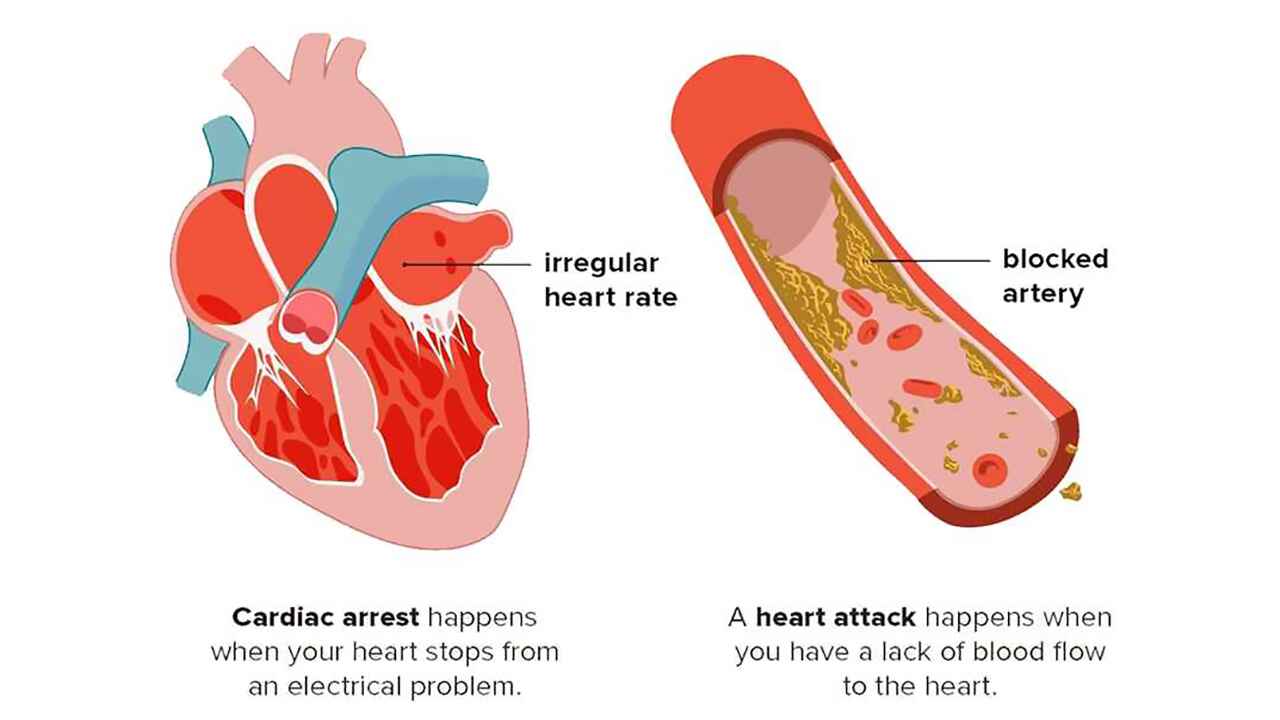When a blockage occurs in the heart (coronary) arteries due to a buildup of fat, cholesterol, high blood pressure, and other substances, blood flow to the heart is severely reduced and a person has a heart attack . The fatty, cholesterol-containing deposits are called plaque.
- What Is a Heart Attack?
- What causes a heart attack?
- How common are heart attacks?
- Who is at risk for a heart attack?
- Warning signs of a heart attack
- How Are Heart Attacks (myocardial infarction or MI) Diagnosed?
- What tests are done to diagnose a heart attack?
- Blood tests
- Exercise Stress Test for Heart Attack Evaluation
- Electrocardiogram (EKG/ECG) for Heart Attack Diagnosis
- Imaging tests
- chocardiogram
- Coronary angiography or cardiac catheterization
- Computed tomography (CT) scan of the heart
- Cardiac MRI (Magnetic Resonance Imaging)
- Nuclear heart scan
- What is the difference between a heart attack and a cardiac arrest?
- What is the treatment like after a heart attack?
- What are the complications of a heart attack?
- Life after a heart attack
- Conclusion
What Is a Heart Attack?
A heart attack happens when blood flow to a part of your heart gets blocked, usually by a blood clot. This blockage can damage or even destroy heart muscle if not treated quickly. Think of it like a traffic jam on the highway that’s stopping vital supplies from reaching their destination.
What causes a heart attack?
The main culprit is coronary artery disease (CAD), which occurs when fatty deposits or plaque build up in your arteries. Over time, these plaques can rupture, causing a clot that blocks blood flow. Heart attacks are possible without a ruptured plaque, but they only account for about 5 percent of attacks. Other causes include:
- Spasms in your coronary arteries (caused by drugs like cocaine or severe stress)
- A stroke that causes a tear or rupture in your coronary artery.
- A blockage that started somewhere else in your body, such as a blood clot or air bubble (embolus) that ends up in a coronary artery.
- Rare conditions like spontaneous coronary artery dissection (SCAD)
Other conditions can limit blood flow to your heart over time, such as low blood pressure, insufficient oxygen levels, or an excessively fast heart rate.
How common are heart attacks?
Heart attacks are one of the leading causes of death in the United States, affecting more than 800,000 people each year. But the point is, with a little knowledge and some smart lifestyle choices, you can significantly reduce your risk.
Who is at risk for a heart attack?
Here is a summary of some of the important factors that increase the risk of a heart attack:
- Unhealthy diet
- Smoking
- High blood pressure and cholesterol
- Lack of exercise
- Family history
- Stress
Dr. Paul Dudley White, a founding member of the American Heart Association, says:
Heart attacks can be linked to factors such as diet, alcohol, tobacco, exercise and family history.
Warning signs of a heart attack
Symptoms of this disease vary. Some people may have no symptoms at all. Some people have mild symptoms, while others have more severe symptoms. Here are common symptoms:
- Chest pain or discomfort: It feels like pressure, squeezing, or fullness.
- Pain in other areas: Such as the arms, back, neck, jaw, or stomach.
- Shortness of breath: Even without chest pain.
- Cold sweat, nausea, or lightheadedness: Common, especially in women.
Women often also experience more subtle symptoms, such as fatigue or indigestion.
Keep in mind that sometimes the first sign of a heart attack is sudden cardiac arrest.
How Are Heart Attacks (myocardial infarction or MI) Diagnosed?
If you have symptoms of a heart attack, you should have a physical exam. When you go to the doctor or emergency room, they will check your pulse, blood oxygen level, and blood pressure, and listen to your heart and lung sounds. They will also ask you about the symptoms you are experiencing and what happened.
What tests are done to diagnose a heart attack?
A heart attack is diagnosed using the following:
Blood tests
Check for markers such as troponin, which indicate heart muscle damage.
Exercise Stress Test for Heart Attack Evaluation
This test may involve an electrocardiogram, echocardiogram, or nuclear scan performed during physical activity to determine if your heart is receiving adequate blood flow.
Electrocardiogram (EKG/ECG) for Heart Attack Diagnosis
Measures the electrical activity of the heart.
Imaging tests
Such as a chest X-ray or angiogram to look at blood flow.
chocardiogram
Shows how well your heart is pumping and how well the valves are working.
Coronary angiography or cardiac catheterization
This is a procedure that uses X-rays and contrast dye to show the blood vessels to your heart and can help determine blockages.
Computed tomography (CT) scan of the heart
This provides a highly detailed scan of your heart and blood vessels, revealing any significant narrowing or hardening in the main coronary arteries.
Cardiac MRI (Magnetic Resonance Imaging)
This test uses a powerful magnetic field and computer processing to create an image of your heart. It can show problems with blood flow in the heart’s vessels.
Nuclear heart scan
These scans use a radioactive dye injected into your bloodstream and advanced imaging techniques, like computed tomography (CT), to identify areas of your heart that aren’t receiving enough blood or have been damaged. Common types include single-photon emission computed tomography (SPECT) and positron emission tomography (PET) scans.
What is the difference between a heart attack and a cardiac arrest?
A heart attack and a cardiac arrest are two serious but completely different medical conditions.
Heart attack: occurs when blood flow to part of the heart muscle is reduced or stopped due to a blockage in a coronary artery. This blockage is usually caused by a buildup of fatty plaque or a blood clot.
Cause: It is caused by coronary artery disease and a gradual decrease in blood flow to the heart.
Cardiac arrest: is an emergency condition in which the heart suddenly stops working, cutting off blood flow to the brain and other organs.
Cause: It usually occurs due to electrical abnormalities in the heart (such as ventricular fibrillation or tachycardia).
What is the treatment like after a heart attack?
It usually includes:
- Medications: Blood thinners, clot busters, or nitroglycerin.
- Procedures: Like angioplasty (opening blocked arteries) or bypass surgery.
“Quit smoking, as it significantly increases your risk of heart attack,” says Dr. Evan S. Levine, a cardiologist at Mount Sinai Health.
What are the complications of a heart attack?
Complications associated with heart attacks:
- Anxiety
- Depression
- Arrhythmias
- Heart failure
- Cardiac shock
- Heart valve problems
- Sudden cardiac arrest
- Stroke
Life after a heart attack
Recovery after a heart attack is very important. Cardiac rehabilitation programs can help you regain your strength, adjust your lifestyle, and even improve your mental health.
Nancy Brown, CEO of the American Heart Association, emphasizes the preventability of cardiovascular disease: 80 percent of cardiovascular disease is preventable.
Conclusion
Although heart attack and cardiac arrest are both related to the heart, their mechanisms, symptoms, and treatments are different. Knowing the differences between the two can be very effective in helping people in need and responding quickly in emergency situations.














